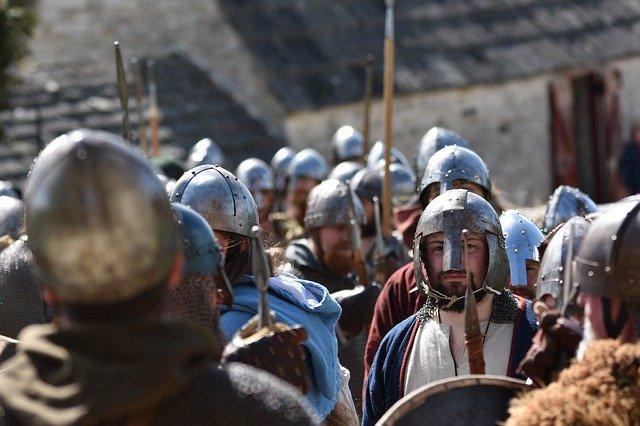Strange problems that prevented ancient people from living in peace

Everyone knows about the fundamental problems that people faced in the ancient past. They had too little food, too many diseases, shabby clothes and inadequate housing.
It is also not surprising that dirt and disease reigned everywhere. But cultures of the past also faced more subtle problems, from additional fungal contamination and exposure to lead to bloody raids.
They were forced to eat fungus
The Pueblo crop in the southwestern United States originated around 400 BC. For the next 800 years, corn was the mainstay of their diet (80 per cent of all calories). Naturally, with such a diet, meat was scarce, the Pueblo people were constantly undernourished.
But they did not suffer from the pellagra (vitamin deficiency) that one would expect with constant nutritional deficiencies. The salvation of Pueblo was found in the fungus Ustilago maydis that infects corn (aka corn blister smut).
Today, this pathogenic fungus is considered a pest then; it was specially included in the diet in those days due to the plenty of proteins and amino acids. Children in Mexico eat this stuff even today.
General beer
Chemical analysis showed direct evidence that the Mesopotamians loved beer. When researchers examined various items from the Kani Masi (Kurdish region of Iraq), they found a remnant of beer consumed between 1500 and 1000 BC.
Mesopotamian beer was similar to modern beer – it was made from barley, not rice or corn, like the ancient Chinese and Peruvian “beer”. But the process of drinking the drink was different. Instead of using personal utensils, the Mesopotamians drank from large standard containers through long metal-tipped straws.
The Mesopotamians eventually began drinking from personal pocket vessels as social traditions weakened. The capacity of these portable “flasks” was about 600 millilitres.
Ancient people suffered from lead
Even Neanderthals were exposed to lead, and scientists discovered signs of this in the teeth of two Neanderthals found in southern France. The researchers studied teeth because the teeth are somewhat reminiscent of tree rings (in the fetus and newborn, a new layer of enamel builds upon them every day, and these layers capture the chemicals that humans are exposed to).
Researchers can also argue that 250,000year-old Neanderthals were poisoned with lead and lived during freezing weather.
Based on the ratios of oxygen isotopes, it was found that Neanderthals experienced more severe autumn and winter, and their children were often malnourished and sick. They probably got lead from contaminated food or water or inhaled it with the smoke of fires,
The ubiquitous parasites
Much can be discovered by examining dried ancient faeces—for example, 700-year-old parasites recovered from stool samples collected from 31 medieval latrines in Lubeck, Germany.
Lubeck was one of the noisiest parts of the Middle Ages, and the intestines of the people have riddled with tapeworms and roundworms thanks to a diet that abounded in “heavy” and improperly cooked freshwater fish.
Various parasites have also been found in faeces from different eras, which suggests that around the 1300s, residents switched to a diet that was more meat. Perhaps this was due to the simultaneous development of the leather and meat industries, two industries that polluted the freshwater ecosystem.
Holes drilled in the skull
The ancient Chinese knew a lot about diseases and described numerous diseases and their pathologies on bone plates or tortoise shells. They even knew how to perform a craniotomy over 3000 years ago. Archaeologists at the ruins of Yinxu have discovered two skulls with drilled holes.
One of the skulls belonged to a ten-year-old boy, and a round hole 1 cm in diameter was found in it. The bone showed signs of healing; that is, the boy survived after the operation. The operation was most likely performed using bone needles, four of which were found in ruins. These are not the first ancient Chinese skulls with holes; 13 such skulls were previously discovered in Xinjiang ruins.
Women were not spared during mass conflicts
As shown by a study of 378 Scandinavian skulls dating from 3900 BC. until 1700 BC (late Stone Age, when the transition to agriculture began), women were not immune to violence in ancient society. The researchers found that one in six of these Stone Age skulls showed signs of severe trauma.
Nearly 10 per cent of the skulls from Sweden and 17 per cent from Denmark showed signs of violence, with both women and men suffering from fatal head injuries. The discovery refutes the theory that women were spared, and researchers believe the injuries were caused by local war, family feuds, or raids.
Bedbugs
Bedbugs are not a modern problem, as recent finds in the Paisley Caves in Oregon have shown. Inside the caves, researchers found the oldest members of the bedbug family.
The recovered fragments of ancient bedbugs date back approximately 11,000 years and are much older than the previously thought to be the oldest 3,500year-old specimen found in Egypt in 1999. Unlike prevalent crop bed bugs, the species found in Oregon is a parasite of bats, not humans.
Limited entertainment choices
Despite their more dynamic lifestyles, the people of the Bronze Age were bored too. And when they got bored, there were quite a few games to choose from. One game that quickly spread from the Middle East was called 58 Holes or Hounds and Jackals.
Researchers have found a “playing field” with holes carved into the floor of a 4,000year-old cave in Azerbaijan. Players used cubes to move their pieces, with the ultimate goal of reaching the top hole.
Hounds and jackals may have been the forerunner of backgammon and served as a “social lubricant” that helped disparate groups share their culture.
Ancient caries
In a public burial ground in Taforalt Cave, Morocco, 52 adults who lived between 15,000 and 13,700 years ago were found. Almost all of the remains had decayed teeth; only three people did not have caries.
More than half of the teeth in the rest of the people showed signs of decay, with 49 out of 52 full of holes in their teeth. Usually, people of that era did not have such rotten teeth since tooth decay only appeared to introduce barley and wheat into the diet.
But these hunter-gatherers appear to have bitten and gnawed too many nuts, North African acorns, legumes, and oats. They probably used a chopping tool found in the excavation to grind these foods into tortillas or sweet, sticky porridge, the bits of which would get stuck in their teeth and harbour the bacteria that cause tooth decay.
Dogs in the diet
The Xoloitzcuintle, or Mexican Hairless Dog, appeared about 3500 years ago; it is one of the oldest dog breeds. In the Aztec language, Nahuatl, “Xolotl”, was the god of death and lightning (who supposedly created this breed), and Itzcuintli meant “dog”.
The Aztecs revered dogs as protectors and guides in the afterlife, who helped the dead get to Mictlan (Aztec Hell). In the region encompassing the present states of Colima, Nayarit and Jalisco, small ceramic figurines of Scholoitzcuintle were found in 75 per cent of burials.
Even though the Aztecs honoured their pets, they also ate them and considered them a delicacy. When the conquistadors arrived, they also began to eat Xoloitzcuintle, which almost led to the breed’s extinction.




